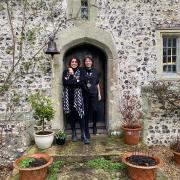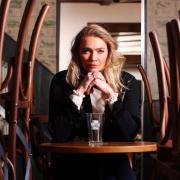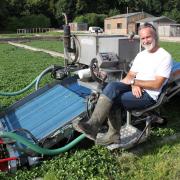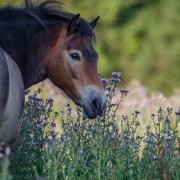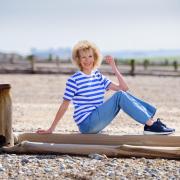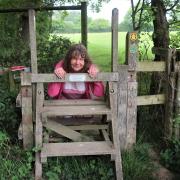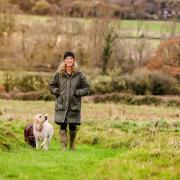Sarah Raven, one of the UK’s leading plantswomen, is not one to let the grass grow under her feet. Angela Wintle meets her at her Sussex home to discover what drives her success
It’s never easy setting up an interview with Sarah Raven. A legendary workaholic, she fills every minute of every day and is the queen bee of multi-tasking. Eventually, she proposes a very specific interview slot. “I can do 2pm next Tuesday. Otherwise, my week is flat out,” she says, though you sense she wouldn’t have it any other way.
As well as running a thriving internet and mail-order plant company, she runs a garden and cookery school and is a best-selling writer, journalist, broadcaster, lecturer and campaigner. And did I mention she has two daughters and three step-sons?
“Yes, I’m always busy,” she nods. “Some people thrive on that and I am one of them. I work hard, but I play hard, too.”
We meet at Perch Hill, her beautiful old farmstead near Burwash Weald in East Sussex, to discuss the reissue of her 1996 gardening classic, The Cutting Garden, which was largely responsible for the revival in growing flowers and foliage for the home.
“There’s nothing like going out into the garden and picking flowers for the house,” she says. “It’s the gardener’s equivalent of collecting new-laid eggs from nesting boxes. It’s a personal harvest, a gathering of good and life-enhancing things that you have nurtured yourself.”
You can always tell home-grown flowers from their commercially grown, shop-bought equivalents, she adds. “Commercial flowers are bred for their regularity and reliability, not for their relaxed, blowsy, open look, scent and character. And with a cutting garden, you see the flowers as a growing crop, and what would have felt untouchable in the main part of the garden can be guiltlessly harvested.”
But how many people have the space to grow the range of cut flowers she features in her book? Can it be done on a smaller scale? “Yes, definitely. We have lots of customers with 3x4m patches, which is what you need to get three arrangements a week.”
It was her late father, John Earle Raven, the leading botanist and Cambridge don, who inspired her love of flowers. Most weekends they would head off in his Morris Minor, in search of wild flowers. But it wasn’t until much later, when she took maternity leave while training as a doctor at the Royal Sussex Hospital in Brighton, that she hit upon the idea of creating her own cutting garden.
“I wasn’t very good at doing nothing, so I ended up setting up a contract floristry business in London,” she says. “Through that, I discovered there were some nice things available from the flower markets, but knew as a gardener that there were a lot of things that weren’t available, and that drove me to grow my own cut flowers.
“Inevitably, because I’m quite greedy, I wanted a lot for a little, so I opted to grow from seed rather than plants, which entailed a wait. That’s why I got into annuals because you can cut and come again – and they’re very cheap to grow.”
There wasn’t a good book for growing annuals, so she began teaching courses on how to grow flowers from a barn on her Perch Hill farm. “We’d be growing annuals from seeds that I had imported, and people in my classes would ask: ‘Can you get me some of those seeds?’” Sarah kept a list of those requests and soon amassed a sizeable potential customer base. From that, she produced her own seed catalogue and from flowers progressed to vegetable seeds and plants. Appearances on Gardeners’ World followed, plus books and enough money to expand. Now she has 50,000 customers and plans to move into northern Europe. From small seeds do thriving businesses grow.
When I ask what her influence has been, she says that’s for others to answer, though acknowledges that she intensified the floral colour palette. “I like strong colour, and when I started flowers were very bridal. I like rich colours – Venetian colours I call them – like purples, blues, oranges and crimsons. People tend to be quite scared of strong colour and I wasn’t scared at all.”
The past few months have witnessed seismic changes in the Raven household. Last September Sarah and her husband, the writer, historian and broadcaster Adam Nicolson, returned to Perch Hill after nine years at Adam’s ancestral home, Sissinghurst in Kent – famed for the garden designed by his grandmother, Vita Sackville-West.
“I love the rippled, wooded and hidden nature of this part of Sussex,” she says. “Even though I’ve lived here for 20 years, I can drive down a lane and come across a view I never even knew was there. It’s a hugely underestimated part of the world.”
Life at Sissinghurst, now in the care of the National Trust, was a bitter-sweet experience, charted in painful detail in a BBC fly-on-the-wall documentary which has recently been repeated. Adam, who had proposed a radical scheme to return the estate to its agricultural roots, upset National Trust staff on the ground, many of whom cherished Sissinghurst’s manicured looks; while Sarah, who longed for Moroccan and Italian dishes in the Trust’s restaurant, clashed with the head chef and head gardener, who proved resistant to change. Then there was the lack of privacy – every time they drew the curtains in the downstairs loo they were confronted with at least three people sniffing the climbing rose outside the window.
But it wasn’t the lack of privacy that finally drove them out. “It was much more the fact that at Sissinghurst you live in the equivalent of a school,” says Sarah, with characteristic candour. “There are very strict rules about how you should do things and Adam and I are a bit anarchic; we found that difficult. Coming back here was a natural progression.”
In the long term, they appear to have won the argument. At Sissinghurst, Adam now has his farm, sheep and cattle, new hedges and a water meadow – and many assume the estate has always looked like this. As for Sarah’s enthusiasms, the food and garden, the Trust has appointed a new property manager who “feels that the restaurant has not been something to feel proud of and the garden has got a little bit stuck.” But this, she adds, has nothing to do with her. “I’ve taken a step back.”
Typically, Sarah hasn’t wasted time since her return to Perch Hill. Now that her girls, Rosie, 19, and Molly, 17, have flown the nest, she is currently revamping the family home and has written a new book, Vita’s Sissinghurst, an insider’s take on Sackville-West’s famous garden. It is due to be published next spring. Plans are also afoot for a fortnightly dinner club and fair, in the style of a village horticultural show, where customers will be invited to bring flower arrangements and home produce for Sarah to judge.
She is also planning a new TV series, though it’s currently under wraps. We last saw her on BBC2 last summer, highlighting the threat posed by the disappearing habitat of bees and other pollinating insects, in a series called Bees, Butterflies and Blooms. This followed her monumental book, Wild Flowers, containing portraits of 500 wild flowers all accompanied by gorgeous photographs by Jonathan Buckley.
“Jonathan and I travelled to more than 100 different sites to track down the flowers,” she says. “Sometimes I would find 20 or 30 plants in one place, and Jonathan would lie on his stomach for hours at a stretch photographing them.
“Getting to know wild flowers adds a new layer to the way you experience the world. An ordinary walk is suddenly full of a new cast of characters. But when I took up botanising again in earnest to begin my research, I worried that most of the interesting wild flowers would have gone.
“The UK Biodiversity Steering Group estimates that 97 per cent of lowland semi-natural grassland in England and Wales disappeared during the 50 years leading up to 1984, with the surviving meadows often fragmented and degraded. Almost all our meadow plants are rare as a result and our roadsides have fared little better.
“I’ve turned 50 and you start to take stock. I remember my dad telling me what had disappeared since he was a child, and I can see what has gone since I was young. If we carry on at this rate we won’t have any wild flowers left. We will soon see the repercussions if we destroy the countryside and yet most of us don’t even realise it’s happening.”
If anyone will stop the rot, Sarah will. When I ask what drives her inexhaustible work ethic, she says simply: “I love learning and teaching people about the things I’ve learnt.” It’s not a bad manifesto for life.
***
My Favourite Sussex
Restaurant: We don’t really go to restaurants. We eat at home because I like to cook.
Pub: Rather than go to a pub, I would take a bottle of wine and sit in a field.
Shop: Etchingham Village Shop. It’s a wonderful new village shop crossed with a deli and it has everything from dog food to very good olive oil and fantastic take-out meals made on site.
View: Cuckmere Haven. I love the combination of the Downs with the flowers, the beach and the shape of the winding river coming down.
Place to visit: Brighton. I like going there for a day out with my girls. We go to Cos for clothes and on to the Lanes, where we always find a lamp or vase in the bric-a-brac markets. You can eat well there, too.
***
Open days
Sarah Raven’s forthcoming Perch Hill garden open days will be held on 22 June, 31 July, 24 August and 14 September. For more details or to find out about her courses, visit www.sarahraven.com
The Cutting Garden by Sarah Raven, with photographs by Pia Tryde, is published by Frances Lincoln at £20.




